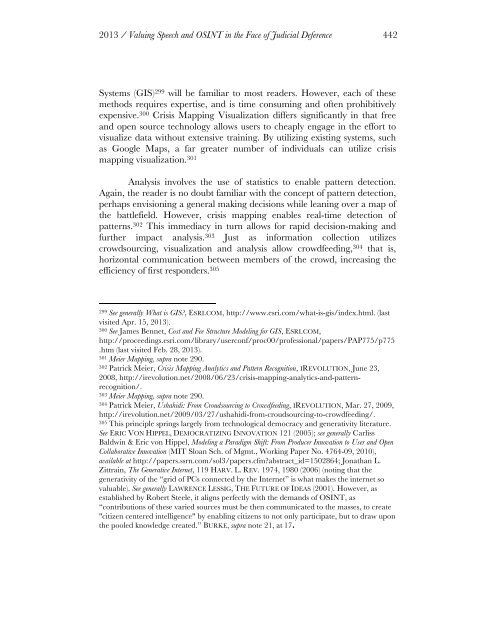Vo.4-Moshirnia-Final
Vo.4-Moshirnia-Final
Vo.4-Moshirnia-Final
Create successful ePaper yourself
Turn your PDF publications into a flip-book with our unique Google optimized e-Paper software.
2013 / Valuing Speech and OSINT in the Face of Judicial Deference 442<br />
Systems (GIS) 299 will be familiar to most readers. However, each of these<br />
methods requires expertise, and is time consuming and often prohibitively<br />
expensive. 300 Crisis Mapping Visualization differs significantly in that free<br />
and open source technology allows users to cheaply engage in the effort to<br />
visualize data without extensive training. By utilizing existing systems, such<br />
as Google Maps, a far greater number of individuals can utilize crisis<br />
mapping visualization. 301<br />
Analysis involves the use of statistics to enable pattern detection.<br />
Again, the reader is no doubt familiar with the concept of pattern detection,<br />
perhaps envisioning a general making decisions while leaning over a map of<br />
the battlefield. However, crisis mapping enables real-time detection of<br />
patterns. 302 This immediacy in turn allows for rapid decision-making and<br />
further impact analysis. 303 Just as information collection utilizes<br />
crowdsourcing, visualization and analysis allow crowdfeeding, 304 that is,<br />
horizontal communication between members of the crowd, increasing the<br />
efficiency of first responders. 305<br />
299 See generally What is GIS?, ESRI.COM, http://www.esri.com/what-is-gis/index.html. (last<br />
visited Apr. 15, 2013).<br />
300 See James Bennet, Cost and Fee Structure Modeling for GIS, ESRI.COM,<br />
http://proceedings.esri.com/library/userconf/proc00/professional/papers/PAP775/p775<br />
.htm (last visited Feb. 28, 2013).<br />
301 Meier Mapping, supra note 290.<br />
302 Patrick Meier, Crisis Mapping Analytics and Pattern Recognition, IREVOLUTION, June 23,<br />
2008, http://irevolution.net/2008/06/23/crisis-mapping-analytics-and-patternrecognition/.<br />
303 Meier Mapping, supra note 290.<br />
304 Patrick Meier, Ushahidi: From Croudsourcing to Crowdfeeding, IREVOLUTION, Mar. 27, 2009,<br />
http://irevolution.net/2009/03/27/ushahidi-from-croudsourcing-to-crowdfeeding/.<br />
305 This principle springs largely from technological democracy and generativity literature.<br />
See ERIC VON HIPPEL, DEMOCRATIZING INNOVATION 121 (2005); see generally Carliss<br />
Baldwin & Eric von Hippel, Modeling a Paradigm Shift: From Producer Innovation to User and Open<br />
Collaborative Innovation (MIT Sloan Sch. of Mgmt., Working Paper No. 4764-09, 2010),<br />
available at http://papers.ssrn.com/sol3/papers.cfm?abstract_id=1502864; Jonathan L.<br />
Zittrain, The Generative Internet, 119 HARV. L. REV. 1974, 1980 (2006) (noting that the<br />
generativity of the “grid of PCs connected by the Internet” is what makes the internet so<br />
valuable). See generally LAWRENCE LESSIG, THE FUTURE OF IDEAS (2001). However, as<br />
established by Robert Steele, it aligns perfectly with the demands of OSINT, as<br />
“contributions of these varied sources must be then communicated to the masses, to create<br />
"citizen centered intelligence" by enabling citizens to not only participate, but to draw upon<br />
the pooled knowledge created.” BURKE, supra note 21, at 17.
















